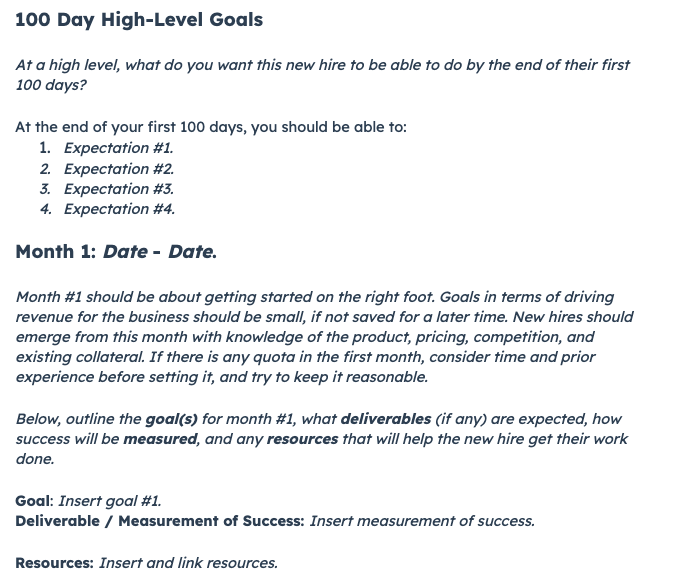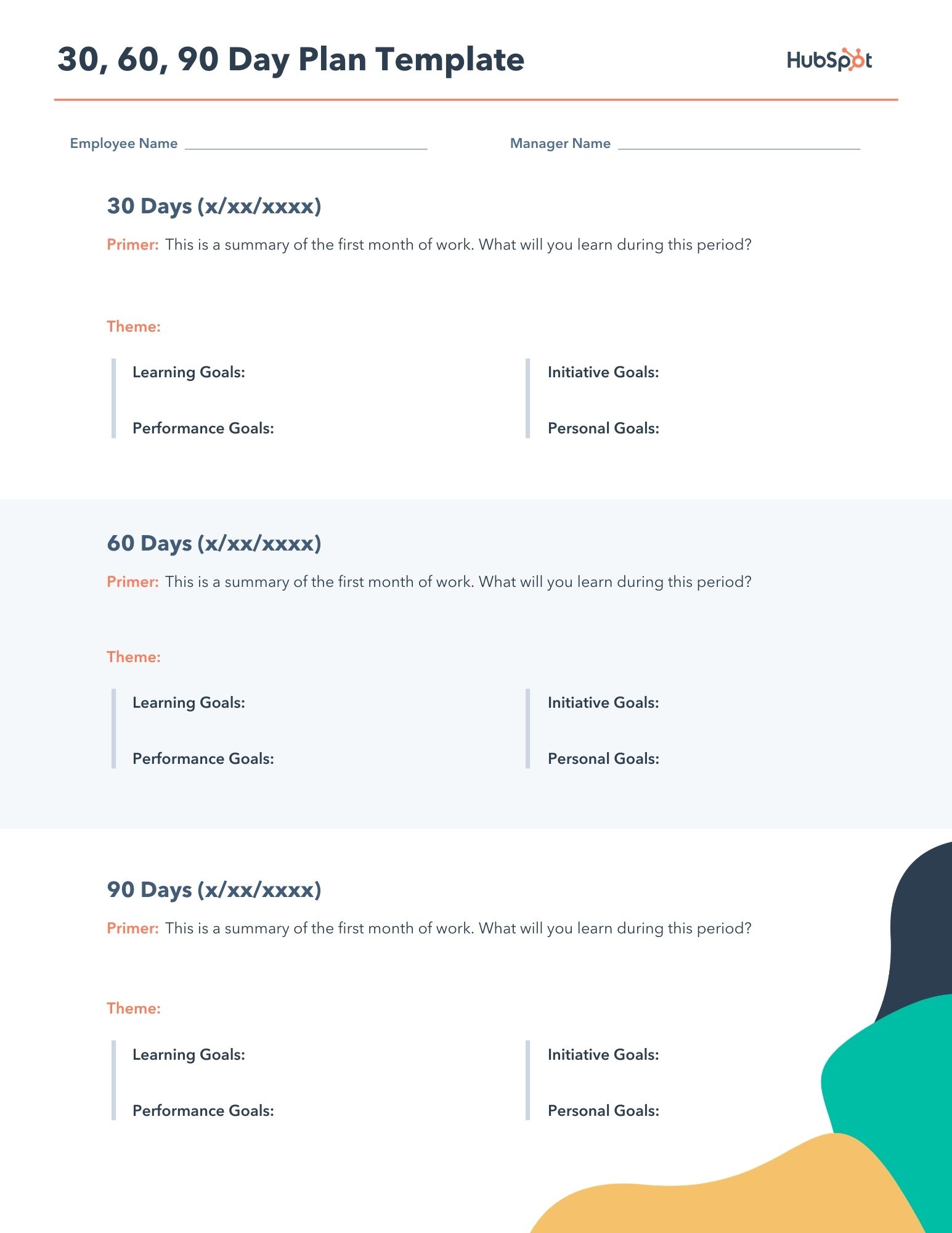Worry often comes along with the excitement of a new job. What if you can't adapt to new people, processes, and team-wide dynamics quickly enough to make a great impression?
Fortunately, there's a way to organize and prioritize your time and tasks, helping you seamlessly adapt to your new environment: The 30-60-90 day plan. Creating and following an effective plan enables you to soak in as much information as possible, master your core job responsibilities, and make a lasting impact on your new team.
In this post, we'll cover everything you need to know about building the best 30-60-90 day plan for your new job.
Learning the nuances of your new role in less than three months won't be easy. But crafting a strong 30-60-90 day plan is your best bet for accelerating your development and adapting to your new work environment as quickly as possible.
There are two situations where you'd write a 30-60-90 day plan: during the final stages of an interview process and during the first week of the job itself. Here's how each type can be executed:
30-60-90 Day Plan for Interview
Some hiring managers ask candidates to think about and explain their potential 30-60-90 day plan as a new hire. They want to see if they can organize their time, prioritize the tasks they'd likely take on, and strategize an approach to the job description.
For a new hire, a well thought-out 30-60-90 day plan is a great way to help the hiring manager visualize you in the role and differentiate yourself from all other candidates.
Of course, it can be difficult to outline your goals for yourself before you accept a new job. So, how are you supposed to know what those goals are? Start with the job description. Normally, open job listings have separate sections for a job's responsibilities and a job's qualifications. Work to find commonalities in these two sections, and how you might turn them into goals for yourself staggered over the course of three months.
For example, if a job requires three years of experience in Google Analytics, and the responsibilities include tracking the company's website performance every month, use these points to develop an action plan explaining how you'll learn the company's key performance metrics (first 30 days), strengthen the company's performance in these metrics (next 30 days), and then lead the team toward a better Google Analytics strategy (last 30 days).
30-60-90 Day Plan for New Job
The second situation where you'd write a 30-60-90 day plan is during the first week of a new job. If you're the hiring manager, this plan will allow you to learn how the new employee operates, address any of their concerns or preconceived notions about the role, and ultimately help them succeed.
If you're starting a new job, and are not asked to craft a 30-60-90 day plan during the first week of that job, it's still a good idea to write one for yourself. A new job can feel like a completely foreign environment during the first few months, and having a plan in place can make it feel more like home.
Even though 90 days is the standard grace period for new employees to learn the ropes, it's also the best time to make a great first impression.
The purpose of your plan is to help you transition into your new role, but it should also be a catalyst for your career development. Instead of just guiding you over your job's learning curve, the goals outlined in your plan should push you to perform up to your potential and raise your bar for success at every stage.
Parts of a 30-60-90 Day Plan
An effective 30-60-90 day plan consists of three larger phases — one for days 1-30, one for days 31-60, and one for days 61-90.
Each phase has its own goal. For example, the goal in the first 30 days is to learn as much as possible about your new job. The next 30 focus on using learned skills to contribute, and the last 30 are about demonstrating skill mastery with metrics and taking the lead on new challenges.
Each phase also contains components that help define goals and describe desired outcomes. These parts include:
Primer
The primer is a general overview of what you hope to achieve during the current 30-day period. It's worth sitting down with your manager to pinpoint a primer that's in line with both your goals and desired company outcomes.
Theme
The theme is a quick-hitter sentence or statement that sums up your goals for the period. For example, your theme might be “find new opportunities”, “take initiative,” or “be a sponge.”
Learning Goals
Learning goals focus on skills you want to learn or improve to drive better outcomes at your job. For example, if you're responsible for creating website content at your company, you might want to learn new HTML or CSS skills.
Performance Goals
Performance goals speak to specific metrics that demonstrate improvement. These might include making one more content post per week or reducing the number of revisions required by management.
Initiative Goals
Initiative goals are about thinking outside the box to discover other ways you can contribute. This might mean asking your manager about taking ownership of new website changes or upgrades with a specific deadline in mind.
Personal Goals
Personal goals focus on company culture — are there ways you can improve relationships with your team members or demonstrate your willingness to contribute?

30-60-90 Day Plan for Managers [Template]
Almost all 30-60-90 day plans consist of a learning phase, a contributing phase, and a leading phase — which we'll go over in the example plan below. This includes plans that are designed to guide people in new management roles. What sets apart a manager's plan from any other is their obligation to their direct reports and the decisions they're trusted to make for the business.
If you're accepting (or hiring for) a new manager role, consider any of the following goals and how to roll them out at a pace that sets you up for success.
Featured Resource: 30-60-90 Day Sales Onboarding Template
Download the Free Onboarding Template
Get to know your team's strengths and weaknesses.
Recommended phase: First 30 days
Everyone is learning the ropes in their first month at a company. For managers, much of that learning happens by talking to the team.
If you're a new manager, grab some time with your direct reports and get to know their roles. What do they like about them? What are their biggest pain points?
Making your team happy is a hard goal to measure, but it's an important responsibility to take on as a manager. Your first step is to figure out how you'll manage and coach your employees through their day-to-day work.
Help a direct report acquire a new skill.
Recommended phase: Second 30 days
Even though you're new to the company, you were hired for a reason: You've got skills. And you can bring these skills to the people you work with, particularly those people who report to you.
After meeting with and learning about your new colleagues, you might use the second month of your on-boarding plan to find skill gaps on your team that you can help fill.
Do you have expert-level experience with HubSpot, and your new company just started using HubSpot Marketing Hub? Teach them how to do something in the platform they didn't know before.
Improve the cost-effectiveness of your team's budget.
Recommended phase: Final 30 days
Managers often have access to (and control over) the budget for their department's investments — things like software, office supplies, and new hires. After you spend the first couple of months learning what the team spends its money on, consider using the final 30 days of your plan to make suggestions for new investments or how to reallocate money where you think it needs to be.
Is there a tool that can automate a task that's taking your team forever to do manually? Draft a financial strategy that includes this tool in the following quarter's budget.
Draft a training strategy that can help guide your direct reports into new roles.
Recommended phase: Final 30 days
You won't be expected to promote people in the first three months of your new job, but that doesn't mean you shouldn't have learned enough about your team to decide who's good at what and how to coach them to where they want to be.
In the final 30 days of your 30-60-90 day plan, you might agree to a goal to develop a training strategy that outlines how to manage your direct reports, and ultimately how to guide them into new roles in the future.
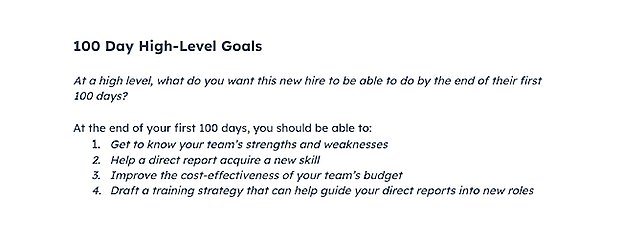
30-60-90 Day Plan for Executives
Executives are a little different from managers in that there are higher performance expectations coming in. As an executive, you'll need to be highly engaged with the organization from the first day and implement high-impact changes in your role as soon as you can. At the same time, context is important, and you'll need to understand the culture, team, current operating processes, and challenges before you solve for them.
Here are some critical steps to include in your 30-60-90 day plan in an executive role.
Soak up as much information as possible.
Recommended phase: First 30 days
There's no point in taking action without context, so start your ramp-up period by gathering information and charting the lay of the land. That means reviewing existing documentation, attending as many meetings as you can, meeting with direct reports and skip levels, and asking a lot of questions.
Create alignment between you and the team.
Recommended phase: First 30 days
In the first 30 days, you'll be meeting new people and understanding their roles in the organization. Ultimately, your job as an executive is to set the vision for the organization while removing roadblocks for your team as they strategize and execute on it.
One of the best questions you can ask as you familiarize yourself and align with your team is, “In your opinion, what are some existing threats to our business (external or internal)?”
This shows that you care about their opinion and trust their expertise while getting unique perspectives from multiple vantage points in the organization. Plus, if you start hearing some of the same points from multiple team members, you'll be able to identify the biggest pains, equipping you to make the highest impact changes.
Identify the A players on the team.
Recommended phase: First 30 days
An A player is a member of your team that goes above and beyond what's expected in their role. While not every employee will be an A player, you'll want to ensure that critical roles and teams have at least one A player to lead, inspire, and strengthen camaraderie.
From there, you can figure out the existing gaps in staffing and training, whether it's team members who need a lot of guidance and must be coached up to performance or empty roles that need to be filled altogether.
Create goals based on what you've learned.
Recommended phase: Second 30 days
When you are interviewing or shortly after you're hired, you'll get a feel for the types of pains that the executive team has and the objectives in mind for bringing you on.
Once you have more context about how the organization works, you can take this vision and translate it into concrete, measurable goals that will take your department to the next level.
Diagnose process issues.
Recommended phase: Second 30 days
Companies of all sizes run into operational issues as they implement processes that are efficient and work at scale. Sometimes, when an executive team isn't aligned with middle management, processes can become unwieldy.
Learn why things are done the way they are and then figure out if there are workarounds you can implement to streamline operations. Perhaps it's as simple as eliminating bottlenecks or adding automation to certain functions.
Put together and implement a hiring plan.
Recommended phase: Final 30 days
You know your A and B players, and you hopefully have a plan to retain, invest in, and mentor them. However, you'll likely come across gaps that you need to fill and positions that need to be created to eliminate bottlenecks. From there, you'll want to create a hiring plan to execute, both for short-term, middle-term, and long-term needs.
Effect changes in operations.
Recommended phase: Final 30 days
Speaking of bottlenecks, your final 30 days of your plan should be focusing on the areas of the business that can achieve the results the fastest. Once you've identified these, you can focus on removing these roadblocks to start hitting goals and achieving higher performance.
Contribute to broader company goals.
Recommended phase: Final 30 days
As a member of the executive team, you'll also be looped in one high-level company initiatives, and the other executives of the company will be relying on you to contribute your deep discipline, expertise, and experience.
Be ready to lean in on executive meetings and contribute to the vision and strategy of the organization as it moves forward.
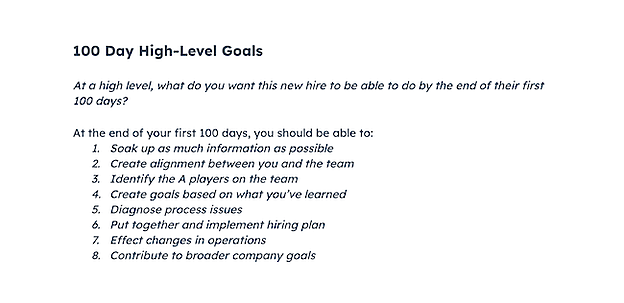
How to Write a 30-60-90 Day Plan
No matter what the level of the job for which a company is hiring, improving an employee's skills requires concrete performance goals, so watch out for vagueness in the objectives you set for yourself.
“Write a better blog post,” or “get better at brainstorming” are terrific ambitions, but they don't give you a way to measure your progress in them. Set goals that are realistic, quantifiable, and focused. You'll know exactly how to achieve them and gauge your success.
To write challenging yet feasible performance goals, you need to:
Understand your team's goals.
Try to understand the purpose behind your team's goals. It'll give you more insight into why you and your team should achieve them, motivating you to work as hard as possible to meet those goals.
Identify top priorities.
By connecting your personal responsibilities to your team's goals, you'll know exactly how to align your tasks with the needs of the team, which keeps you accountable and compels you to help your team achieve their goals.
Define specific progress measurements.
Tracking your progress helps you gauge your performance and rate of improvement. To see how you're doing, set up weekly meetings with your manager to ask her what she thinks of your work and track the improvement of your own performance metrics, like the growth of your blog posts' average views or the amount of qualified leads your eBooks generate.
Reaching your performance goals isn't the only path toward future success in your new role, though. You also need to study the ins and outs of your team and company, take initiative, and develop relationships with coworkers — all things that a lot of new hires underestimate the importance of.
Consider setting the following types of goals during each stage of your 30-60-90 day plan:
- Learning Goals How will you absorb as much information as possible about your company, team, and role?
- Initiative Goals – What will you do to stand out?
- Personal Goals – How will you integrate with your company and team?
Aiming to achieve these types of goals will help you hit the ground running in all the right areas of your job. And if you stick to your plan, you'll notice you'll be able to spend less time learning and more time executing.
30-60-90 Day Plan Template
HubSpot's 30-60-90 day plan template includes space for all key elements of your plan — primers, themes, and goals — making it easy for both you and your manager to see exactly where you are in the plan, what comes next, and how things are going so far.
While our template is a great starting point, it's worth cross-referencing this high-level plan with a more detailed description of your goals and desired outcomes to ensure you're aligned with company expectations.
30-60-90 Day Plan Example
Using our template, we've created a quick 30-60-90 plan example for new employees.
30 Days
Primer
Many new hires are eager to impress, so they dive head-first into their work or try to make suggestions about their team's process with limited experience in how their new team operates. But have patience.
Understanding your company's vision and your team's existing strategy is crucial for producing high-quality work and actually making an impact. If you don't know the purpose behind your role or the optimal way to perform, you'll risk missing the mark and your early efforts won't pay off the way you expect them to.
It's always better to over-prepare than under-prepare. And it's okay to take time to learn the ropes — it pays huge dividends in the long run. In the first 30 days of your employment, your priority is to be a sponge and soak in as much information as possible. Once you do that, you can then try to improve more specific parts of your team's work style.
Theme: Be a Sponge
Learning Goals
- Study my company's mission, vision, and overarching strategy.
- Read my company's culture code to learn more about our company culture and why we implement it.
- Read the customer persona and target audience overview to truly understand who our customers are, their pain points, and how our product and content can help them.
- Meet with my team's director to learn about how meeting our goals will help our business grow.
- Read up on our team's new SEO strategy, editorial process, and traffic goals.
- Learn how to use the SEO Insights Report to plan and structure blog posts.
- Review my team's pillar-cluster model overview and understand how to match posts to clusters.
- Meet with my manager to learn more about her expectations.
Performance Goals
- Complete new hire training and pass the test with a 90% or higher.
- Be able to write 3 blog posts per week.
Initiative Goals
- Run the Facebook Instant Article experiment that my manager recommended me to do.
Personal Goals
- Grab coffee with everyone on my team, so I can get to know them on a professional and personal level.
60 Days
Primer
By the end of your first 60 days, you should ramp up your workload, start overachieving, and make a name for yourself on your team.
To do this, start speaking up more at meetings. Don't be afraid to share your ideas about improving your team's processes. This shows you're quickly conquering the learning curve and recognizing some flaws that your colleagues might have overlooked. You still have a fresh perspective on the company, so your insight is invaluable.
Theme: Be a Contributor
Learning Goals
- Learn how to optimize a new post from scratch based on both the SEO Insights Report and my own competitive research.
- Read every other marketing team's wiki page to learn about other marketing initiatives and how our entire department works together to grow our business.
- Deep dive into my company's product roadmap and strategy to fully grasp our mission and vision.
Performance Goals
- Be able to write 5 blog posts per week.
- Be down to one cycle of edits per post.
- Understand how to edit a guest post — clean up at least one rough draft.
Initiative Goals
- Share content strategy ideas at my team's monthly meeting and ask if I can spearhead the project to boost blog traffic.
- Ask my manager if I can oversee Facebook messenger and Slack distribution strategy.
Personal Goals
- Meet with my colleagues on other teams to learn about their marketing initiatives and develop relationships outside of my team.
90 Days
Primer
By the end of your first three months, you should have a firm grasp of your role, feel confident about your abilities, and be on the cusp of making a breakthrough contribution to your team. Instead of reacting to problems that pop up at random, be proactive and spearhead a new initiative for your team.
You should also be cognizant of how you can collaborate with other teams to improve your own team's processes. By taking on some new projects outside of your main role, you'll start turning some heads and catch the attention of the department at large.
Theme: Be a Leader
Learning Goals
- Do an analysis of my highest and lowest-performing blog post to date. How can I use this information to optimize new content so it performs better out of the gate?
Performance Goals
- Be comfortable with writing five blog posts per week
- Edit one guest post per week
- Try to have 75% of my blog posts not require revisions.
- Write at least one new post that generates over 10,000 views in one month.
Initiative Goals
- Ask SEO team if they want to partner with the product marketing team to brainstorm content topics related to our product road map.
- Ask social media team if they're willing to develop a relationship where we can share each other's content.
- Ask sales team what our customers' pain points are, so we can write content that our target audience craves and help them close more qualified leads.
Personal Goals
- Join the yoga club.
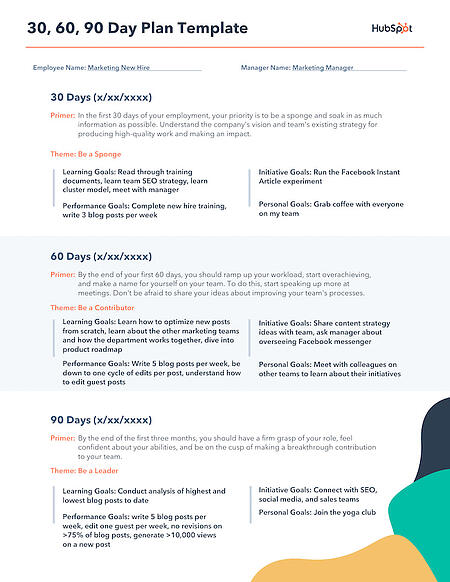
30-60-90 Day Plan Team Leader Example
Now, let's apply that same template to a team leader role with another 30-60-90 plan example.
30 Days
Primer
During the first 30 days, the goal of a team leader should be to cultivate connections with their team members and discover where they excel, where they struggle, and where they could use help. Creating these relationships lays the foundation for solid communication over time, in turn leading to better results.
Theme: Cultivate Staff Connections
Learning Goals
- Identify strengths for all team members.
- Pinpoint current challenges in accomplishing team goals.
- Encourage staff connections through honest communication.
Performance Goals
- Reduce project completion times by 25 percent.
- Increase team member output by 5 percent.
Initiative Goals
- Establish a mentorship connection with one staff member looking to advance in their role.
Personal Goals
- Arrange one out-of-work activity for staff.
60 Days
Primer
For the second month, team leaders may want to focus on putting the connections they've made to good use and creating a mindset of success across the department. In practice, this means establishing clear goals and specific metrics and working alongside staff to deliver key outcomes.
Theme: Create a Culture of Success
Learning Goals
- Understand where previous team leaders have struggled.
- Identify common themes in goals not being met.
- Clearly define starting points, milestones, and end goals for projects.
Performance Goals
- Ensure current project deadlines are met.
- Deliver at least one project component ahead of schedule.
- Take ownership of one complex task to continue developing team culture.
Initiative Goals
- Based on current project goals, brainstorm two new potential projects.
- Look for ways to integrate current efforts with sales, marketing, or social media teams.
Personal Goals
- Make time for mindfulness practice at work to help improve your focus.
90 Days
Primer
The last month of your 30-60-90 plan may focus on ensuring the framework you've built can be replicated on the next team project and finding new opportunities for your team members to excel.
Theme: Identify New Opportunities
Learning Goals
- Convene with staff to see what worked and what didn't during the project.
- Look for outcomes that exceeded expectations and discover what sets them apart to help drive improved processes.
Performance Goals
- Become confident in assigning staff specific tasks with minimal oversight.
- Create a regular performance review structure that focuses on helping staff achieve their best work.
- Identify areas for reasonable cost-savings that don't disrupt current processes.
Initiative Goals
- Look for team members with a passion for leadership and encourage their growth.
- Transition into a more hands-off leadership style that demonstrates trust in employee autonomy.
Personal Goals
- Take up a new hobby to avoid getting burned out at work.
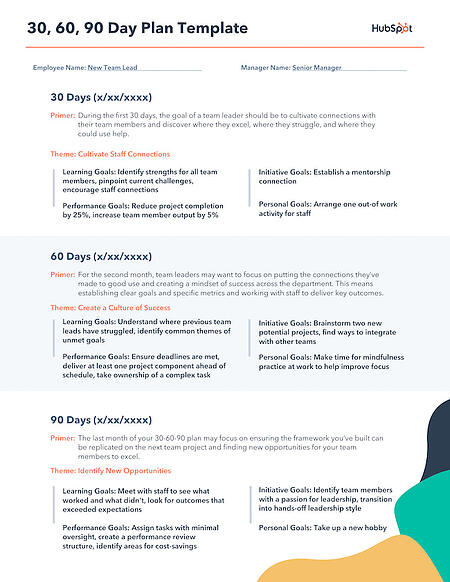
30-60-90 Day Plan Marketing Strategist Example
30 Days
Primer
During the first 30 days, the marketing strategist will analyze current campaign performance to discover what works, what doesn't work, and how strategy can be improved. The marketing strategist will also work with team members and stakeholders to learn more about existing processes. Investigating performance lays the foundation for how strategy can improve in the future.
Theme: Analyze Current Performance
Learning Goals
- Get familiar with the company's product, mission, positioning, and goals.
- Consult with stakeholders to discuss existing processes, tools, and buyer personas.
- Learn about completed and ongoing experiments and their results.
Performance Goals
- Conduct content audits and competitor analyses in order to uncover performance gaps.
Initiative Goals
- Meet with sales reps, account managers, and customer support team members to learn more about customer wants and needs.
Personal Goals
- Get lunch with new team members in order to get to know them better.
60 Days
Primer
By day 60, the marketing strategist will have identified performance gaps based on the work done during the first 30 days and begun work on brainstorming ways to close those gaps.
Theme: Identify Performance Gaps
Learning Goals
- Research and brainstorm potential new processes that will help improve performance gaps.
Performance Goals
- Identify areas for improvement based on the results of the performance audits and competitive analysis.
Initiative Goals
- Meet with finance team to discuss budget for new marketing experiments and initiatives.
- Deliver an experiment proposal that is aimed at improving one of the gaps found during the audits.
Personal Goals
- Join an interest-based Slack channel to connect with colleagues on other teams.
90 Days
Primer
For the third month, marketing strategists may focus on ensuring the research framework they've built can be replicated for new projects and launch experiments aimed at closing performance gaps.
Theme: Launch New Experiments
Learning Goals
- Identify performance outcomes that exceed expectations and see what sets them apart from outcomes that do not exceed expectations.
Performance Goals
- Develop a system for measuring and analyzing campaign performance.
Initiative Goals
- Launch a new experiment aimed to help close a performance gap discovered during earlier analyses.
Personal Goals
- Spend a few hours working at the new neighborhood coffee shop to change up routine.

Making the Most of Your First Months
The first few months at a new job are critical in answering key questions: Is the company a good fit? Can you meet (and exceed) expectations? What does your long-term career plan look like?
Building a robust 30-60-90 day plan can take some of the pressure off by providing a framework for success that combines big ideas with specific goals to help drive success.
Editor's note: This post was originally published in April 2019 and has been updated for comprehensiveness.

![The Best 30-60-90 Day Plan for Your New Job [Template + Example]](https://no-cache.hubspot.com/cta/default/53/1dc09795-02c8-4fbe-a62b-a1d669dec2c5.png)
![Download Now: Sales Training & Onboarding Template [Free Tool]](https://localseoresources.com/wp-content/uploads/2022/12/1dc09795-02c8-4fbe-a62b-a1d669dec2c5.png)
